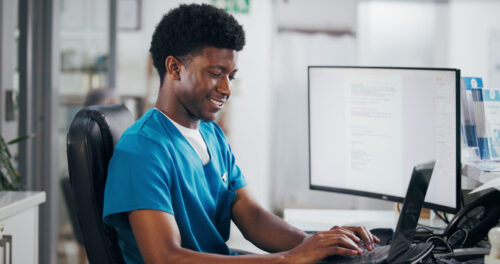
Talk with a ChartSpan Representative Today!
Our team is ready to help you improve patient care and outcomes.
Blog
Fall Risk Assessments & Fall Prevention for Older Patients
Falls are among the leading causes of injury and accidental death in the United States. The risk of older individuals dying from a fall outpaces motor vehicle accidents, unintentional poisonings, and drug overdoses.
Even when they are not immediately fatal, falls can have serious implications on the physical and mental health of patients. Broken hips can permanently restrict mobility, limiting patients' ability to exercise and care for themselves independently. Fear of falling can cause patients to become homebound, resulting in social isolation and depressive episodes. The expenses incurred from fall-related hospitalizations, surgeries, and therapies are significant and may be unaffordable for many older patients.
Fortunately, while falls are common, they are preventable. A comprehensive fall risk assessment is a vital tool for identifying and addressing key factors that increase a patient’s risk. You and your patients can collaborate through these assessments to create safe, hazard-free home environments. You can recommend alterations to their lifestyles to eliminate risky behaviors and address medical conditions that exacerbate the chances of falling. Then, you can support patients as they make those changes through preventive care programs.
In this article, we will explore why fall risk assessments are vital and how preventive care programs encourage patient safety, mobility, and longevity.
What is a fall risk assessment?
A fall risk assessment is a series of questions used to determine an older adult’s risk of falling and injuring themselves based on their overall health, habits, and lifestyle. Healthcare providers administer these assessments to categorize whether a patient is at low, moderate, or high risk of falling.
With the results of a fall risk assessment, you can make recommendations to minimize the likelihood of a patient falling and mitigate the consequences of a fall. This can include changes to exercise, diet, medications, home furnishings, and footwear. For example, a person may need to remove clutter from the walkways in their home or start exercising regularly to improve their balance.
What patients need fall risk assessments?
The CDC’s Older Adult Fall Prevention initiative recommends yearly fall risk screenings and assessments for every adult over 65. A wide array of factors influence a patient’s chances of falling. Here are a few examples:
- Poor balance
- Reduced muscular strength
- Impaired mobility
- Deteriorated vision
- Chronic illnesses like hypertension, diabetes, and osteoporosis
- Cognitive impairment
- Depression
- Substance abuse disorders
- Environmental factors, like homes with steep stairs, loose rugs, or slippery tiles
- Medications that cause dizziness upon standing, drowsiness, or lightheadedness
- Ill-fitting shoes and restrictive clothing
- Deficiencies in Vitamin D and other minerals
All of these elements will be reviewed by the provider or care manager performing a fall risk assessment.
The importance of assessing fall risk in patients
For older adults, a simple fall can have serious consequences. Every year, 30% of people over 65 experience a fall. While some falls may only result in mild bruising, others can cause serious injuries like fractured hips or traumatic brain injuries, such as subdermal hematomas. Falls are the leading cause of death from injury in American adults over 65.
Even when they are not fatal, falls can permanently alter a patient’s mobility and elevate their anxiety. After a fall, patients may suffer from reduced capacity for activities, socialization, and independence Losing these capacities can have serious implications for pre-existing chronic conditions, mental health, and long-term clinical prospects. The injuries, disabilities, and fears triggered by falls can make maintaining muscle mass, bone health, and regular exercise routines much harder.
Falls are also associated with higher use of emergency services. Ambulance rides, hospitalizations, and physical therapy are all added expenditures that will increase patients’ healthcare costs and can cause financial strain.
Educating patients on fall prevention strategies through Chronic Care Management
Chronic Care Management (CCM) is a Medicare program created to improve preventive care among patients managing multiple chronic illnesses. CCM aims to strengthen the connections between patients and providers, boost healthcare engagement, facilitate positive clinical outcomes, and encourage patient retention.
CCM care managers provide enrolled patients with monthly calls to discuss wellness goals, medication management, care coordination, and Social Determinants of Health (SDOHs), along with any other concerns or questions the patient raises. These check-ins are also prime opportunities for patient education.
If a care manager is concerned that a patient is at risk of falling, they can verbally discuss fall risks and the potentially severe consequences. They can also send the patient peer-reviewed written material to further educate them on the importance of reducing their fall risk through lifestyle and environmental adjustments.
How does CCM help patients minimize their risk of falls?
Recurring monthly calls from a care manager are prime opportunities to proactively identify and address fall risks. Care managers can identify risk factors and alert the appropriate care providers.
For example, while following up on exercise goals with a diabetic patient, the patient may mention feeling unsteady on their feet after walking. The care manager can then explore if the patient is concerned about losing balance or slipping on stairs. In collaboration with the overseeing healthcare provider, they can set fall risk mitigation goals with the patient.
These goals can include the construction of a ramp to the patient’s home entrance or installing a stair lift. The care team can help patients find a vendor to install these and follow up with the patient on the project’s progress.
Care managers’ assistance with medication refills, transportation arrangements, and lab requests demonstrates their investment in the patient’s care journey and encourages the patient to take an active role. Patients enrolled in CCM may be more receptive to feedback and behavioral changes because of the trust and respect built through this compassionate communication and assistance.
Ongoing conversations between care managers and patients also allow CCM team members to make early interventions based on the information they gather during calls. If they notice a patient is past due for an eye exam, they can assist the patient in scheduling an appointment and closing the gap in care. This promotes patient safety by ensuring that the patient’s ocular prescription is up-to-date and that they don’t fall because of poor vision
Care managers can also identify risk factors for depression, like oversleeping or the recent loss of a partner. They can then provide resources like referrals to their provider or to local support groups. To identify other factors that might lead to falls, they may ask about the patient’s exercise frequency, use of canes or walkers, medication adherence, incontinence, chronic joint pain, and many other fall risk factors. All of this knowledge can help care managers create individual care plans and risk minimization strategies.
Learn more: Chronic Care Management: Benefits, Reimbursements, and Requirements.
Optimizing Annual Wellness Visits with fall risk screenings
Annual Wellness Visits (AWVs) are yearly opportunities for patients to personalize their treatment plan based on their unique health history, risk factors, and medical conditions. These annual reviews are remarkable opportunities to actively engage patients in their healthcare journey and customize wellness solutions based on their preferences and needs.
AWVs use Health Risk Assessments (HRAs) to ascertain the holistic health profile of a patient. These customizable questionnaires review an individual patient’s conditions, cognition, physical ability, medications, nutrition, and habits. The information is then used to create screening schedules, lifestyle adjustments, and wellness plans to match the specific needs and risks of the patient.
AWVs have been found to reduce the risk of falls and fractures in older American adults. One study conducted in Texas reported that patients who received an AWV were less likely to fall in the 24-month observation period following their wellness visits. This positive correlation was even more pronounced among patients living in rural areas and patients with multiple chronic conditions.
Broader studies have determined that AWVs reduce healthcare costs by as much as 6% per patient. This study underscores the power that AWVs have to positively transform patient outcomes.
How do AWVs reduce fall-related injuries?
AWVs are perfect opportunities for healthcare providers to determine a patient’s fall risk and create targeted interventions around these risks. Since AWVs are conversations centered around patient-centered, preventive care strategies, fall risks can arise naturally during the dialogue.
For example, patients may mention that their medications cause them to be dizzy upon standing. You can then ask them about their levels of physical activity and balance, how often they have to climb stairs in their home, or if they wear stabilizing footwear. You can then proactively incorporate strategies to minimize fall risks into the patient’s wellness plan.
When your practice encourages Medicare beneficiaries to receive AWVs, you create meaningful opportunities for clinical interventions and reduce fall risks among at-risk patient populations.
Learn more: The Ultimate Annual Wellness Visit Checklist for Providers
Proactive fall prevention with ChartSpan's preventive solutions
ChartSpan offers industry-leading preventive care services designed to optimize patient outcomes, elevate your practice’s quality of care, and open recurring revenue streams through Medicare’s reimbursement programs. Our full-service CCM program and proprietary RapidAWV™ software can help lower your patient’s fall risk through targeted wellness interventions, robust communication, and patient engagement.
ChartSpan’s fully-managed CCM program
CCM brings demonstrated clinical benefits to enrolled patients and opens new revenue channels for practices*. However, it’s difficult for most practices to implement independently due to the program’s added workload, complexity, and infrastructural demands.
ChartSpan’s turnkey CCM program solves the challenges many practices face when integrating CCM into their practice. Through ChartSpan, your practice can access trained enrollment specialists, care managers, established telephonic technologies, and industry-leading strategies promoting preventive services and elevating the quality of care. Our CCM service provides dedicated representatives who will facilitate smooth integration and ensure maximized reimbursements for the services rendered.
Through our CCM program, we can help reduce the risk of your patients injuring themselves through unintentional falls. A regular cadence of calls fosters regular opportunities for care managers to review fall risks with patients and create action plans to address them.
Care managers will follow up with patients on your practice's care goals and risk-reduction measures. They will also share any new and relevant information they obtain with your office, granting you ongoing insight into a patient’s progress and the development of any new complications and concerns.
*Results may vary by provider.
ChartSpan’s flexible, streamlined AWV software
Our customizable, user-friendly AWV software smoothly integrates into your practice’s workflow. Upon completing the HRA, RapidAWV™ creates comprehensive, actionable reports based on patient responses. By identifying each patient’s personalized risk factors, our AWV software can prioritize recommended preventive screenings and provide patients with insightful health summaries.
We’ve designed our AWV technology to be accessible to older patients and clinical staff. Patients can complete the HRA from the comfort of your practice’s waiting room during routinely scheduled appointments. The questionnaires are optimized for performance across iOS and Android devices and can be administered via tablets.
You can customize HRAs to include questions specific to their practice or specialty. RapidAWV™ software ensures you never miss an opportunity for preventive engagement by performing real-time eligibility checks on your patient lists. With ChartSpan’s RapidAWV™, you can expand your opportunities to identify and address fall risks before they have the chance to become life-altering events.
Through active collaboration, ChartSpan can assist your practice in fostering safety and stability in your older patient population. Contact us to learn more about the transformative benefits we can bring to your practice’s preventive care strategies.
You may also like:
Subscribe for More Insights
Get valuable resources delivered straight to your inbox.
"*" indicates required fields






